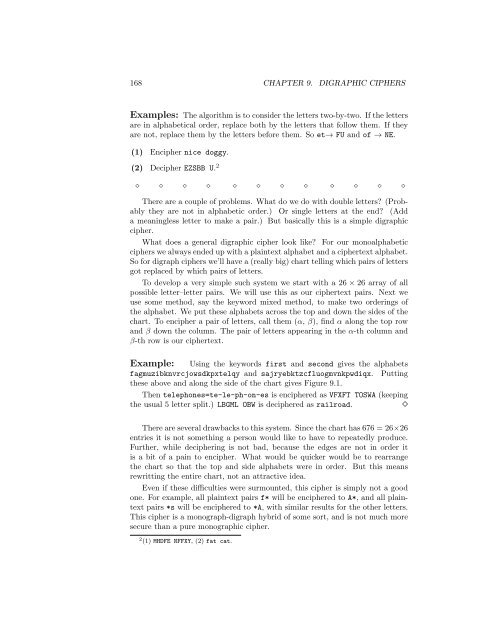Cryptology - Unofficial St. Mary's College of California Web Site
Cryptology - Unofficial St. Mary's College of California Web Site
Cryptology - Unofficial St. Mary's College of California Web Site
You also want an ePaper? Increase the reach of your titles
YUMPU automatically turns print PDFs into web optimized ePapers that Google loves.
168 CHAPTER 9. DIGRAPHIC CIPHERS<br />
Examples: The algorithm is to consider the letters two-by-two. If the letters<br />
are in alphabetical order, replace both by the letters that follow them. If they<br />
are not, replace them by the letters before them. So et→ FU and <strong>of</strong> → NE.<br />
(1) Encipher nice doggy.<br />
(2) Decipher EZSBB U. 2<br />
⋄ ⋄ ⋄ ⋄ ⋄ ⋄ ⋄ ⋄ ⋄ ⋄ ⋄ ⋄<br />
There are a couple <strong>of</strong> problems. What do we do with double letters (Probably<br />
they are not in alphabetic order.) Or single letters at the end (Add<br />
a meaningless letter to make a pair.) But basically this is a simple digraphic<br />
cipher.<br />
What does a general digraphic cipher look like For our monoalphabetic<br />
ciphers we always ended up with a plaintext alphabet and a ciphertext alphabet.<br />
So for digraph ciphers we’ll have a (really big) chart telling which pairs <strong>of</strong> letters<br />
got replaced by which pairs <strong>of</strong> letters.<br />
To develop a very simple such system we start with a 26 × 26 array <strong>of</strong> all<br />
possible letter–letter pairs. We will use this as our ciphertext pairs. Next we<br />
use some method, say the keyword mixed method, to make two orderings <strong>of</strong><br />
the alphabet. We put these alphabets across the top and down the sides <strong>of</strong> the<br />
chart. To encipher a pair <strong>of</strong> letters, call them (α, β), find α along the top row<br />
and β down the column. The pair <strong>of</strong> letters appearing in the α-th column and<br />
β-th row is our ciphertext.<br />
Example: Using the keywords first and second gives the alphabets<br />
fagmuzibknvrcjowsdkpxtelqy and sajryebktzcfluogmvnkpwdiqx. Putting<br />
these above and along the side <strong>of</strong> the chart gives Figure 9.1.<br />
Then telephones=te-le-ph-on-es is enciphered as VFXFT TOSWA (keeping<br />
the usual 5 letter split.) LBGML OBW is deciphered as railroad. ⋄<br />
There are several drawbacks to this system. Since the chart has 676 = 26×26<br />
entries it is not something a person would like to have to repeatedly produce.<br />
Further, while deciphering is not bad, because the edges are not in order it<br />
is a bit <strong>of</strong> a pain to encipher. What would be quicker would be to rearrange<br />
the chart so that the top and side alphabets were in order. But this means<br />
rewritting the entire chart, not an attractive idea.<br />
Even if these difficulties were surmounted, this cipher is simply not a good<br />
one. For example, all plaintext pairs f* will be enciphered to A*, and all plaintext<br />
pairs *s will be enciphered to *A, with similar results for the other letters.<br />
This cipher is a monograph-digraph hybrid <strong>of</strong> some sort, and is not much more<br />
secure than a pure monographic cipher.<br />
2 (1) MHDFE NFFXY, (2) fat cat.

















